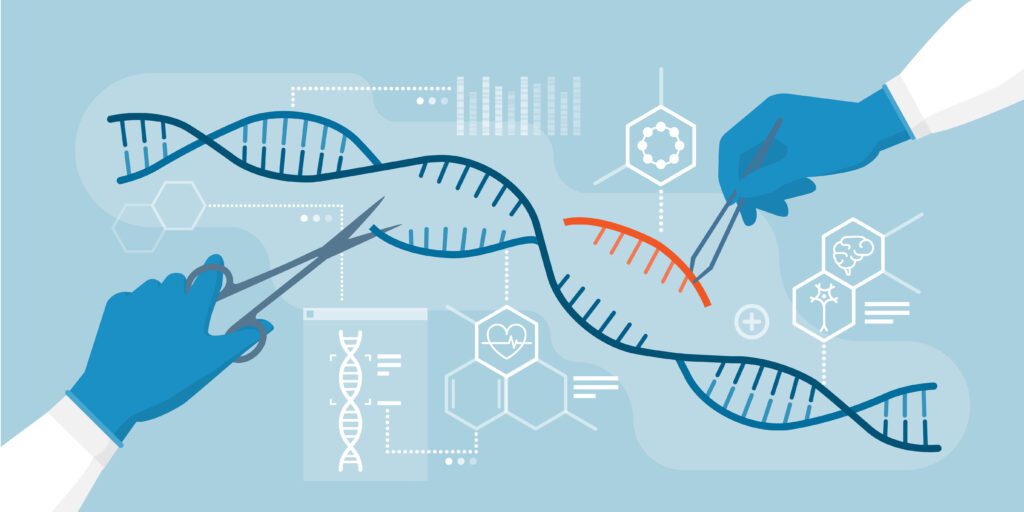Breakthroughs in Gene Editing: The Path to Curing Genetic Diseases and Healing People

Unraveling the secrets of the genetic code has been one of the most transformative journeys in the history of science. The advent of gene editing technologies has taken this discovery to unprecedented levels, offering a gateway to a future where genetic diseases can be treated and human abilities enhanced. As we navigate this inexhaustible terrain, not only the scientific community but also medical professionals, genetics enthusiasts, and science students will benefit from the profound knowledge and potential applications emerging from the field of gene editing.
Gene Editing: More Than a Cutting-Edge Science
Gene editing technology is not just a field of science fiction; It forms the basis of medical research that allows scientists to manipulate DNA with precision once thought impossible. At the heart of gene editing are tools such as CRISPR-Cas9 and Transcription activator-like effector nucleases (TALENs), which allow researchers to insert, delete or replace genetic material at specific locations within the genome.
Implications of this technology are already being seen in the advancement of treatments for numerous genetic diseases. New treatments powered by gene editing offer hope in the fight against diseases such as sickle cell anemia and cystic fibrosis. These advances serve as evidence of the evolving capabilities of gene editing and point to a future in which diseases previously considered fatal may be made treatable or even curable.
Developing Human Capabilities: Ethical Boundaries
Gene editing is fueling not only medical victory, but also heated debates surrounding human development. Beyond preventing disease, gene editing holds the potential to enhance human abilities, whether it is increasing physical abilities or strengthening cognitive functions. But this possibility brings us to an ethical crossroads, raising questions about its implications for equality, human identity, and the sanctity of life.
While these debates are necessary, they do not hinder the advancement of science. Rather, they underscore the need for a measured and consensus-based approach to the responsible use of gene editing. As we reflect on the limits of human development, it is crucial to recognize the transformative potential of gene editing and at the same time connect our aspirations to the virtues of ethical innovation.
The Current Outlook for Gene Editing: Victory over Genetic Diseases

There are a number of pioneering therapies that demonstrate current achievements in the field of gene editing. For example, the application of CRISPR-Cas9 in the treatment of sickle cell anemia has emerged as a success that promises to bring respite to millions of people suffering from this inherited blood disorder. Similarly, TALENs have played an important role in combating diseases such as muscular dystrophy, providing a beacon of hope for patients with this progressive muscle wasting disorder.
These examples of gene editing triumphs demonstrate that the horizons of possibility are expanding and that the tools to achieve these therapeutic breakthroughs are available in the precision of genetic tools. These stand not just as medical miracles, but as harbingers of a future in which personalized genetic medicine addressing the unique genetic makeup of individuals may become the norm.
Gene Editing Case Studies: Changing the Course of Genetic Diseases
The real-world application of gene editing has yielded a pantheon of case studies that challenge the narrative that genetic diseases are insurmountable. In a landmark case in 2020, researchers used CRISPR technology to deliver gene therapy for cystic fibrosis, marking a significant leap forward in a battleground where conventional medicine has long struggled to keep up.
Another notable example comes from a study conducted jointly by the US and China in which a patient was cured of transthyretin amyloidosis, an aggressive and life-threatening genetic disorder. This bold application of CRISPR in the human body paves the way for in vivo gene editing and underscores the potential of gene therapies to rewrite the story of rare genetic conditions.
Future Prospects and Challenges in Gene Editing
When we look at the future of gene editing, we see a landscape bright with promise and fraught with challenges. On the one hand, promising developments such as base editing and primary editing techniques point to a future in which erasing genetic diseases is not only a desire but also a defensible goal. On the other hand, regulatory frameworks and ethical dilemmas require a delicate balance between scientific progress and social accountability.
The journey ahead of gene editing is one filled with the complexities of editing and the nuances of ethics. It requires a concerted effort not only from the scientific and medical communities, but also from policymakers and the public at large. Embracing the possibilities of gene editing requires a commitment to a future where innovation and security coexist harmoniously and are guided by the unshakable compass of ethical behavior.
Adopting Responsible Innovation in Gene Editing

The narrative of gene editing is one that challenges us to envision a world freed from the shackles of genetic disease, while also prompting us to consider the implications of enhancing human capabilities. A dual imperative emerges from this discourse: to harness the transformative potential of gene editing toward compassionate medical goals and to undertake this endeavor with the self-imposed caveat of moral responsibility.
We can find the way forward at the intersection of these ideals. Responsible innovation in gene editing not only protects against potential misuses of this powerful technology, but also ensures that our steps in reshaping genetics are compatible with the collective values of our global society. Collaboration between scientists, ethicists, and stakeholders from all walks of life is the catalyst that will make gene editing more than just a capability but a beacon of hope for humanity.
Ultimately, gene editing stands as a profound testament to human ingenuity, offering a range of treatments and the tantalizing prospect of improving our essence. As we continue to navigate these lands, let us do so with the wisdom to discern the right course, the humility to accept the burden of tampering with nature's code, and the courage to imagine a future where genetic diseases are but a memory and the vitality of the human race knows no bounds.
Ultimately, our common destiny in the age of gene editing is a tapestry woven from equal parts caution and courage, investigation and discovery. By continuing to integrate the fields of science, ethics, and social norms, we can ensure that the journey ahead is one of not only cutting-edge research but compassionate and ethical practice with the ultimate goal of benefiting all humanity.
Why Should You Choose Samas?
- Reliability: Samas is a reliable solution partner in the healthcare industry. It gives confidence to customers with its experience and quality service approach.
- 3M Quality: SamasMed offers products from the world-renowned 3M. It provides access to reliable and effective products with high quality standards.
- Wide Product Range: It offers a wide range of products including medical equipment, surgical supplies, hygiene products and more.
- Customer Satisfaction Focus: Samas prioritizes customer satisfaction. It offers the most suitable solutions with its expert staff.
- Fast and Reliable Service: Samas offers fast and reliable service. It strives to meet needs as soon as possible.
Samas is here to meet the needs in the healthcare industry and provide the best service.


Comments are closed